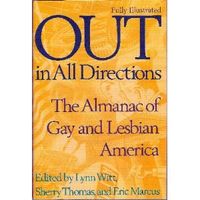 A
Afew years ago the Zurich Zoo in Switzerland conducted guided tours that
centered around homosexual behavior among the zoo animals. Unfortunately,
the one hour tours were held in the early evenings, at a time when most
animals
were asleep. But this did not stop the gay zoo tours from being a
success. Though there was no same-sex activity in evidence, tour guide
Myriam Schärz assured her tourists that same-sex behavior is a common
part of
animal life: “I don’t know of any species that is exclusively
heterosexual,”
Schärz told “swissinfo”, Switzerland’s news and information platform. “Right here in Zurich we once had a gay flamingo couple who remained
partners
for life. In Cologne Zoo they have a pair of lesbian penguins who each
year steal an egg from one of their neighbors and treat it as their
own.”’
“lesser”
species was in 1999. Later that year the standard work on the topic,
Biological Exuberance: Animal Homosexuality and Natural Diversity by
Bruce
Bagemihl, was published. “On every continent, animals of the same sex
seek
each other out and
 have probably been doing it for millions of years,”
have probably been doing it for millions of years,”Bagemihl
wrote. “They court each other, using intricate and beautiful mating
dances
that are the result of eons of evolution. Males caress and kiss each
other, showing tenderness and affection toward one another rather than
just
hostility and aggression. Females form long-lasting pair-bonds – or
maybe
just meet briefly for sex, rolling in passionate embraces or mounting
one
another. Animals of the same sex build nests and homes together, and
many
homosexual pairs raise young without members of the opposite sex. Other
animals regularly have partners of both sexes, and some even live in
communal
groups where sexual activity is common among all members, male and
female. Many creatures are ‘transgendered,’ crossing or combining
characteristics of
both males and females in their appearance or behavior.”
different kinds of animals worldwide, and is found in every major
geographic
region and every major animal group.” But we don’t need Bagemihl for
anecdotal evidence. Hardly a week goes by that we don’t hear stories
about
same-sex oriented otters or rabbits. You don’t have to go to the Zurich
Zoo to learn about “the indiscriminate and almost insatiable sexuality
of bonobo
apes” or “how gay male dolphins use their lovers’ blowholes for sexual
gratification.” Just last year a review paper by Nathan Bailey and
Marlene
Zuk of the Department of Biology at the University of California in
Riverside
concluded that “same-sex behavior is a nearly universal phenomenon in
the animal
kingdom, common across species, from worms to frogs to birds.”
mount each
other while incubating eggs,” Steve Hogan and Lee Hudson wrote in
Completely
Queer: The Gay and Lesbian Encyclopedia. “Similar behaviors have been
documented among female sage grouse, male mallard ducks, and female and
male
 greylag geese and turkeys.” According to the authors of Out in All
greylag geese and turkeys.” According to the authors of Out in All
Directions: The Almanac of Gay and Lesbian America, same-sex behavior
has been
documented in all kinds of animal species, including antelope, bugs,
butterflies, cats, cattle, cockroaches, crickets, dogs, donkeys,
elephants, flies, geckos, guinea pigs, hamsters, horses, hyenas, lions,
martens,
mice, moths, octopuses, orcas, porcupines, raccoons, rats and wasps. “In
1994,” according to the Almanac, “two male flamingos in the Rotterdam
Zoo in the
Netherlands got the nesting urge and set up a same-sex co-habitation. After the two repeatedly sought to steal eggs from female flamingos to
hatch
them as their own, the zookeepers decided to provide them with a
fertilized
egg. he proud parents successfully hatched their own little chick, and
remained faithfully by the side of the baby flamingo for a while.” The
whole world knows about Roy and Silo, two male chinstrap penguins at the
Central
Park Zoo in New York who lovingly hatched and raised an adopted chick,
Tango. (The story of Tango and her two daddies appears in 2005's
often-censored children’s book, And Tango Makes Three, by Justin
Richardson and
Peter Parnell.)
as much
as the human variety, and they have tried their best to deny it. Those
who
do admit that same-sex behavior exists in the animal kingdom try to
explain it
away as being playful antics or dominance behavior to assert hierarchy. “Some conservatives and religious groups now admit that homosexuality is
common
in the animal kingdom, but many of them have also put forward theories
to
explain the phenomenon,” said Myriam Schärz of the Zurich Zoo. “Some
argue
that homosexuality only occurs when animal populations become too large,
or that
animals only turn to homosexuality when they have no other alternative ,
, , But
there is no evidence to back up the population theory, and there is
plenty of
proof against the harem argument. Dominant silver-back gorillas, for
instance, have frequently been seen engaging in homosexual activity and
deliberately shunning available females.”
readily
accepted in society,” Schärz said. “Animal societies tend to stay
together and accept each other. Of course, animals do get excluded
occasionally
but that tends to happen if they get injured or if they are not liked,
rather
than because of their sexuality.” Here is another instance where we
humans
could learn from the animals.
in South
Florida. Send all gay animal tales to him at jessemonteagudo@aol.com.